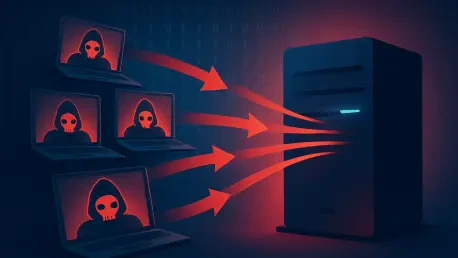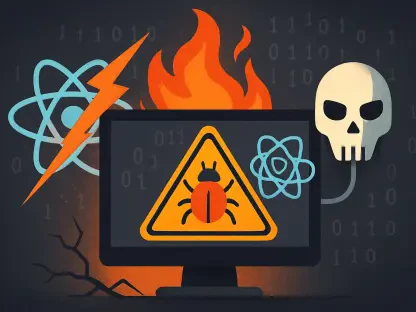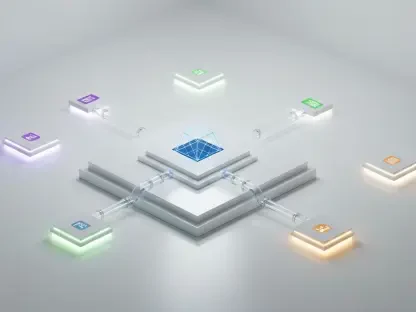In the ever-evolving realm of cybersecurity, a formidable new adversary has emerged, casting a dark shadow over cloud infrastructure with its sophisticated malice that threatens the stability of digital environments. Known as the ShadowV2 botnet, this malicious campaign specifically targets Amazon Web Services (AWS) Docker containers to execute powerful Distributed Denial of Service (DDoS) attacks. Unearthed through meticulous research by cybersecurity experts, ShadowV2 stands out not merely as a piece of disruptive malware but as a fully realized “DDoS-as-a-Service” platform. Its chilling integration of traditional malware strategies with modern cloud-native and DevOps technologies signals a dangerous leap forward in the world of cybercrime. This alarming development underscores a pressing need to understand how such threats operate within trusted environments like AWS, exploiting legitimate tools for nefarious purposes. As digital infrastructures grow increasingly reliant on cloud solutions, dissecting the mechanics and implications of ShadowV2 becomes essential for fortifying defenses against this insidious breed of attack.
Unveiling the Operational Blueprint of ShadowV2
The intricate design of ShadowV2 begins with a calculated assault on vulnerable Docker daemons hosted on AWS EC2 instances, turning these entry points into launchpads for chaos. Threat actors, cloaked behind the anonymity of GitHub CodeSpaces, employ a Python-based spreader to craft Ubuntu containers as their initial staging ground. These containers are then rigged with a Go-based Remote Access Trojan (RAT) alongside DDoS binaries, establishing a robust framework for sustained malicious activity. This multi-layered deployment mirrors the seamless workflows of legitimate DevOps practices, allowing the botnet to blend into routine operations and evade early detection. Once embedded, ShadowV2 establishes persistent communication with a command-and-control (C2) server through regular heartbeat signals and polling requests, ensuring it remains primed to execute attacks with precision based on specified targets and durations, showcasing a disturbingly efficient operational model.
Beyond the initial infiltration, ShadowV2’s ability to scale and adapt within AWS environments reveals the depth of its strategic planning. After deployment, the malware drops a Go-based ELF binary into a designated directory, using environment variables for identification and registration with the C2 server via POST requests. This setup not only secures its foothold but also minimizes traces that could lead to forensic discovery. The botnet’s architecture is designed for resilience, maintaining two continuous loops—one sending a heartbeat every second and another polling for new commands every five seconds. When activated, it can unleash attacks with tailored parameters, such as targeting specific URLs or adjusting thread counts for maximum impact. This level of control and automation within a cloud-native context illustrates how ShadowV2 transforms trusted infrastructure into a weapon, challenging conventional security measures to keep pace with such dynamic threats.
Cutting-Edge Attack Methods and Stealth Strategies
What distinguishes ShadowV2 from more traditional botnets is its arsenal of advanced DDoS techniques, pushing beyond simple flooding to exploit nuanced protocol weaknesses. A standout method is the HTTP/2 rapid reset attack, which capitalizes on the protocol’s multiplexing capabilities to bombard servers with thousands of request streams per connection, overwhelming their capacity to respond. This tactic is particularly devastating as it maximizes disruption with minimal resource expenditure on the attacker’s end. Additionally, ShadowV2 employs large-scale HTTP floods complemented by random query strings and spoofed headers, creating a multi-pronged assault that targets both volumetric overload and specific vulnerabilities within cloud setups. These methods highlight a sophisticated understanding of modern internet protocols, positioning the botnet as a formidable adversary in the digital space.
Further enhancing its elusiveness, ShadowV2 incorporates cunning evasion tactics to bypass robust security mechanisms like Cloudflare’s Under Attack Mode. By deploying a headless Chrome binary to tackle JavaScript challenges, the botnet attempts to masquerade as legitimate traffic, though this approach has met with limited success due to Cloudflare’s advanced detection systems. Nevertheless, such efforts underscore the lengths to which threat actors will go to obscure their activities. The combination of these innovative attack vectors with strategic evasion maneuvers not only amplifies the botnet’s destructive potential but also complicates the task of identifying and neutralizing it. As defenders grapple with distinguishing malicious behavior from benign operations, ShadowV2’s ability to adapt its tactics to counter security updates remains a critical concern for cloud infrastructure protection.
The Commercial Face of Cybercrime Innovation
Far removed from the shadowy, chaotic nature of typical underground botnets, ShadowV2 presents itself with the polish and structure of a commercial enterprise. It features a sleek login panel and an intuitive operator interface, paired with a RESTful C2 framework shielded by Cloudflare and hosted on GitHub CodeSpaces. This setup is not merely functional but user-centric, with an API that facilitates user authentication, privilege differentiation, and detailed attack management. Such elements point to a multi-tenant design, crafted to deliver DDoS capabilities on demand to a diverse clientele. This “Botnet-as-a-Service” paradigm mirrors the usability and scalability of legitimate cloud-native applications, reflecting a disturbing shift toward professionalization in cybercrime where accessibility and customer experience are prioritized alongside destructive intent.
This commercialized approach also suggests a broader, more alarming trend within the cyber threat landscape, where malicious services are marketed with the same finesse as legitimate software solutions. ShadowV2’s infrastructure, complete with admin-only endpoints and blacklist management features, indicates a deliberate focus on reliability and user satisfaction, akin to a subscription-based tech product. The implications of this model are profound, as it lowers the barrier of entry for would-be attackers who may lack technical expertise but can now access powerful tools for hire. By adopting the operational models of successful tech businesses, ShadowV2 not only enhances its reach but also challenges the cybersecurity community to rethink how threats are categorized and countered, moving beyond isolated malware to address organized, service-oriented platforms.
Barriers to Effective Detection and Mitigation
Confronting ShadowV2 poses significant hurdles for cybersecurity professionals due to its adept use of containerization, which leaves scant forensic evidence for analysis. By operating within Docker containers on AWS, the botnet minimizes persistent traces that could aid in tracking its origins or activities. Furthermore, its C2 infrastructure leverages trusted platforms like GitHub CodeSpaces, cloaking malicious communications under the guise of legitimate traffic and complicating efforts at attribution. The botnet’s knack for rapid adaptation, evidenced by undetected samples appearing on VirusTotal in recent months, adds another layer of difficulty, as it continuously evolves to sidestep existing detection mechanisms. These factors collectively render traditional security tools less effective against a threat that so seamlessly integrates with authorized systems.
Adding to the challenge is the inadequacy of conventional perimeter-based defenses against such hybrid threats that blend legitimate tools with malicious objectives. ShadowV2’s ability to mimic routine DevOps processes means that distinguishing between normal and anomalous behavior requires a level of granularity that many current systems lack. Defenders find themselves in a reactive position, struggling to update strategies fast enough to match the botnet’s pace of innovation. The reliance on trusted cloud environments for both operation and concealment further muddies the waters, as blocking or monitoring these platforms risks disrupting legitimate business functions. Addressing this sophisticated adversary demands a fundamental shift in approach, prioritizing deep behavioral analysis and real-time monitoring to uncover subtle indicators of compromise before they escalate into full-scale attacks.
Future-Proofing Cloud Security Against Evolving Threats
The emergence of ShadowV2 serves as a stark warning of the growing trend toward cybercrime-as-a-service, where attackers emulate the scalability and user focus of legitimate enterprises to amplify their impact. Its exploitation of AWS and GitHub for malicious purposes exposes critical gaps in cloud security, necessitating enhanced visibility into container orchestration to detect unauthorized activities at their inception. Implementing stricter access controls for Docker APIs is also paramount to prevent initial breaches that enable botnet deployment. As threats increasingly disguise themselves within routine operations, adopting behavioral analytics to identify unusual network or API usage patterns becomes a cornerstone of effective defense, pushing the boundaries of how cybersecurity must evolve to protect expansive digital ecosystems.
Looking ahead, the broader implications of ShadowV2’s service-oriented model call for a reevaluation of how cyber threats are perceived and addressed. Recognizing these botnets as modular platforms rather than standalone malware is crucial for anticipating future iterations and developing proactive countermeasures. Collaboration across industries to share threat intelligence can further bolster resilience, ensuring that insights into attack patterns like HTTP/2 rapid resets are disseminated swiftly. Strengthening partnerships with cloud providers to enhance logging and monitoring capabilities offers another avenue for disruption, potentially turning the botnet’s reliance on trusted platforms into a point of vulnerability. As cloud environments continue to dominate digital infrastructure, fortifying defenses against such sophisticated adversaries will be an ongoing imperative for safeguarding the integrity of global online systems.









